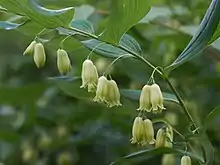Polygonatum biflorum
Polygonatum biflorum (smooth Solomon's-seal, great Solomon's-seal, Solomon's seal). The plant is said to possess scars on the rhizome that resemble the ancient Hebrew seal of King Solomon.[2] This is a species of the genus Polygonatum native to eastern and central North America.[3] It is often confused with Solomon's plume which has upright flowers.
| Smooth Solomon's-seal | |
|---|---|
 | |
| Scientific classification | |
| Kingdom: | Plantae |
| Clade: | Tracheophytes |
| Clade: | Angiosperms |
| Clade: | Monocots |
| Order: | Asparagales |
| Family: | Asparagaceae |
| Subfamily: | Nolinoideae |
| Genus: | Polygonatum |
| Species: | P. biflorum |
| Binomial name | |
| Polygonatum biflorum | |
| Synonyms[1] | |
| |
Description
Unbranched leaf stalks of one to several feet in length, with simple, alternate leaves and parallel veins. In May, clusters of small white-green flowers droop from the stalks and later produce small blue berries. If dug up, the scars resembling Solomon's Seal may be visible on the nodes between sections of rhizomes.
Taxonomy
The species name biflorum is the neuter form of Latin biflorus, meaning "having two flowers". Despite the name, the flower clusters often have more than two flowers.[3]
P. biflorum is now regarded as including a number of other species and varieties, e.g. P. biflorum var. commutatum or P. commutatum.
Uses
Historically, the Native Americans consumed the starch-rich rhizomes of smooth Solomon's-seal as a "potato-like food" used to make breads and soups. The young shoots are also edible, raw or boiled for an asparagus-like food.[4] Smooth Solomon's-seal was also used in herbal medicine. For example, the rhizome was used in making a tonic for gout and rheumatism.[5] Smooth Solomon's-seal has had nearly a dozen uses in herbal medicine including as an anti-inflammatory, sedative, and tonic.[6] Smooth Solomon's-seal is not used in large-scale agriculture.
References
- "The Plant List: A Working List of All Plant Species". Retrieved 17 May 2015.
- Niering, William A.; Olmstead, Nancy C. (1985) [1979]. The Audubon Society Field Guide to North American Wildflowers, Eastern Region. Knopf. p. 605. ISBN 0-394-50432-1.
- Utech, Frederick H. (2002). "Polygonatum biflorum". In Flora of North America Editorial Committee (ed.). Flora of North America North of Mexico (FNA). 26. New York and Oxford – via eFloras.org, Missouri Botanical Garden, St. Louis, MO & Harvard University Herbaria, Cambridge, MA.
- Eric Toensmeier (December 13, 2009). "Polygonatum biflorum var. commutatum – giant Solomon's seal". Retrieved July 28, 2013.
- Bausor, S. C. (1937). "Medicinal Plants of Our Local Flora". Torreya. 373 (3): 45. JSTOR 40597114.
- Duke, J. A. (2002). Handbook of medicinal herbs (2nd ed., pp. 25-26). Boca Raton: CRC Press.
- Blanchan, Neltje (2002) [1900]. Wild Flowers: An Aid to Knowledge of our Wild Flowers and their Insect Visitors. Project Gutenberg Literary Archive Foundation.
- Blanchan, Neltje (2005) [1917]. Wild Flowers Worth Knowing. Project Gutenberg Literary Archive Foundation.
External links
- USDA Plants Profile for Polygonatum biflorum (smooth Solomon's seal)
- Connecticut Botanical Society: Polygonatum biflorum
| Wikimedia Commons has media related to Polygonatum biflorum. |
